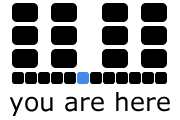Composition
by Jentery, Curtis, Matthew & Jamie
Our method to this point has been to approach questions of tagging, digital archiving, folksonomies, and new media from a variety of disciplinary angles to see what “emerges” both in terms of our group’s “Standards in the Making” (SITM) methodology and its relevance for the larger objective, “the new work of composing.” One deceptively simple question that has been circulating – implicitly or explicitly – through our discussion thus far: how and in what ways is the production of metadata a form of composition? In this investigation we have attempted to open as many doors into this topic as possible, allowing for more discussion and productive dissonance than we can describe here. Nevertheless, our staging of these different responses have managed to describe a kind of feedback loop between the terms and tropes of composition/rhetoric scholarship and the various challenges mounted by new media writing contexts.
To begin, Jamie notes that our focus on SITM expressly dialogues with the field of composition and rhetoric studies, primarily in the way that both are “explicitly and implicitly concerned with the analysis and application of standards.” From this perspective, standards are conceived of as communal “property”—received and deployed as the “readymade” result of a long process of evolution and acceptance within, and across, numerous discourse communities.” This conception, amongst other things, subtly undoes the simple dichotomy between “readymade” and “emergent” standards – between the Standard and SITM – by suggesting that all standards “emerge from discourse.” Composition itself is therefore conceived of as a process of “reading and deploying standards situationally as tools of effective discourse.” In a sense, Curtis’s argument about the “conversational” properties of archival metadata hinges upon this idea.
If composing and mobilizing such a standard is to have any meaning – if it is to achieve the status of an argument – it will construct that meaning, in part, in relation to the other standards that also compete to define the archive and its variously captured objects. This is not only to suggest that any situation of metadata includes both explicit and implicit “readymade” standards (envisioned here as generative constraints), but that the ability to compose meaningful metadata hinges upon the writer’s ability to navigate the previous standards which it is both beholden to and attempting to intervene in. Meaningful metadata is constructed situationally, confirming the need for writers to, as Jamie puts it, “read and respond to the systems of knowledge and discourse in which their work operates.” In this way, the approaches to rhetorical context and situational discourse that Jamie provides suggest a means of imagining the rhetorical “work” of metadata as composition.
Of course, it would be a mistake to neglect the many ways that SITM attempts to critically intervene in the terms and assumptions of traditional compositional practices – the ways that metadata (as Jamie puts it) “responds to different exigencies,” hails different types of audiences, and possibly broadens our conception of “composition” altogether. In the most general sense, metadata “composes” information and data objects within (and potentially across) a variety of digital media, including media archives, maps, and text documents. For Matt, a SITM approach insists upon a productive contingency for these compositions, highlighting their status as “unfinished” and, ultimately, “unfixed” configurations of data:
In thinking SITM, data are always-already practices, in motion, and therefore never resolved. This is not to say that we cannot narrate them, but that our narrations are also contingent, temporary fixes about that which may already be gone, in flight, or remade.
From this perspective, Matt calls for an adjustment in our concept of “endpoints,” productively destabilizing any sense of totalizing Standards with the acknowledgment that all narratives/compositions are, at best, temporary and utterly conditional configurations of data. Adding to this, Jentery notes how SITM “begins with deprivileging the individual scholar as the locus of knowledge production and then moves toward forms of labor that are collaborative in character.” It seems as though SITM’s commitment to “what emerges” from critical, collective inquiry calls for, at a really basic level, a reevaluation of what we mean by (and privilege with) the idea of authorship, as well as the goals and merits of any supposedly “finished” compositional process.
While our responses take up this question from a variety of discordant entry points, each of us understand this perspective as key for approaching what is “new” about the “work” of digital and new media composition. Together these perspectives have suggested that SITM presents a whole series of challenges and opportunities for those interested in digital culture, pedagogy, and new media composition to imagine how writing “works” in these different contexts and practices.
